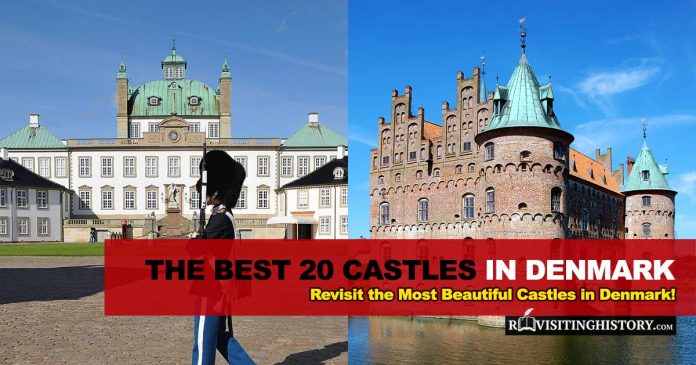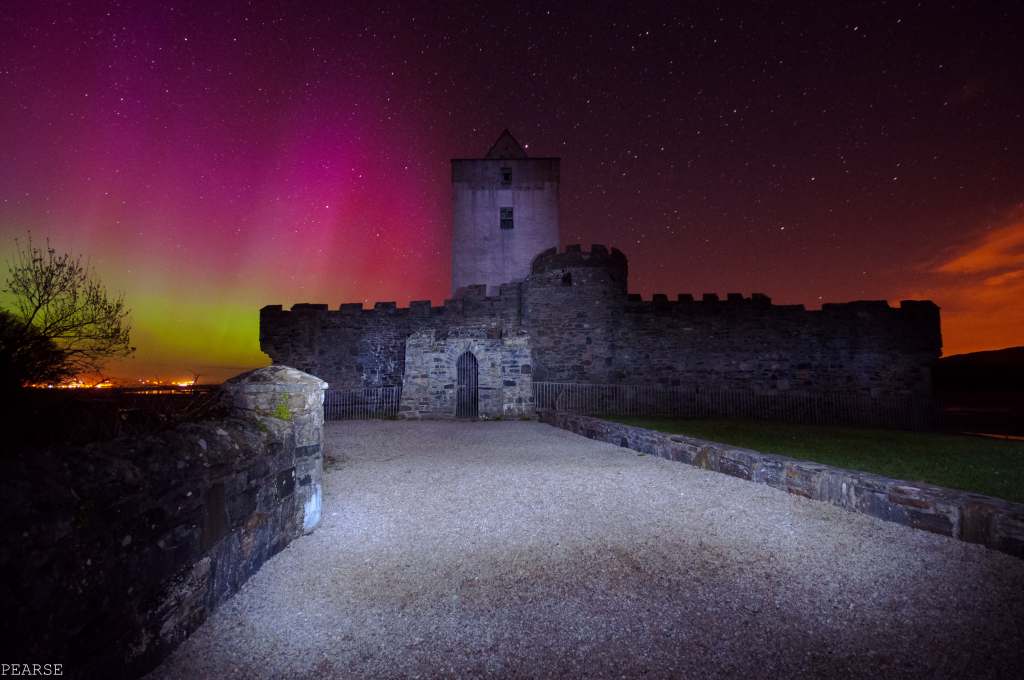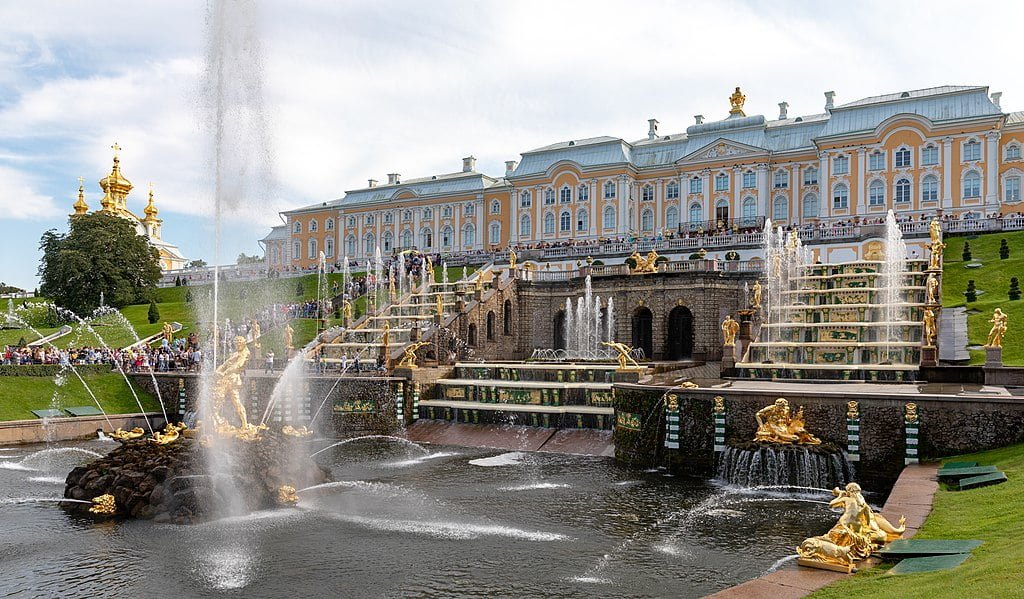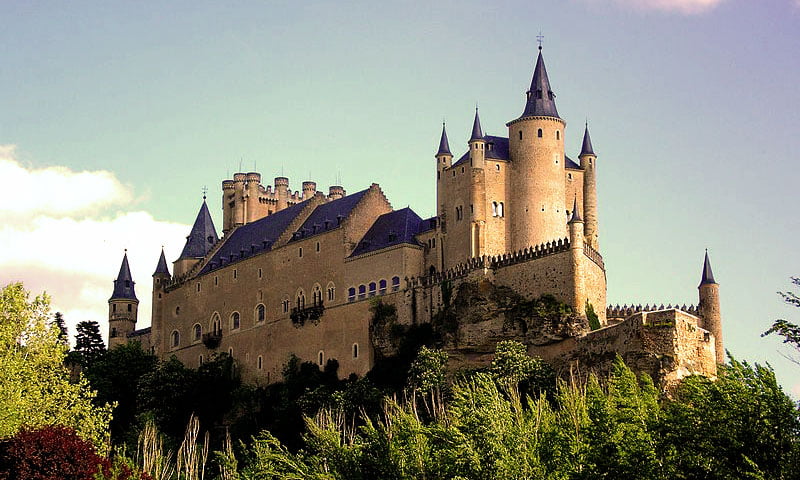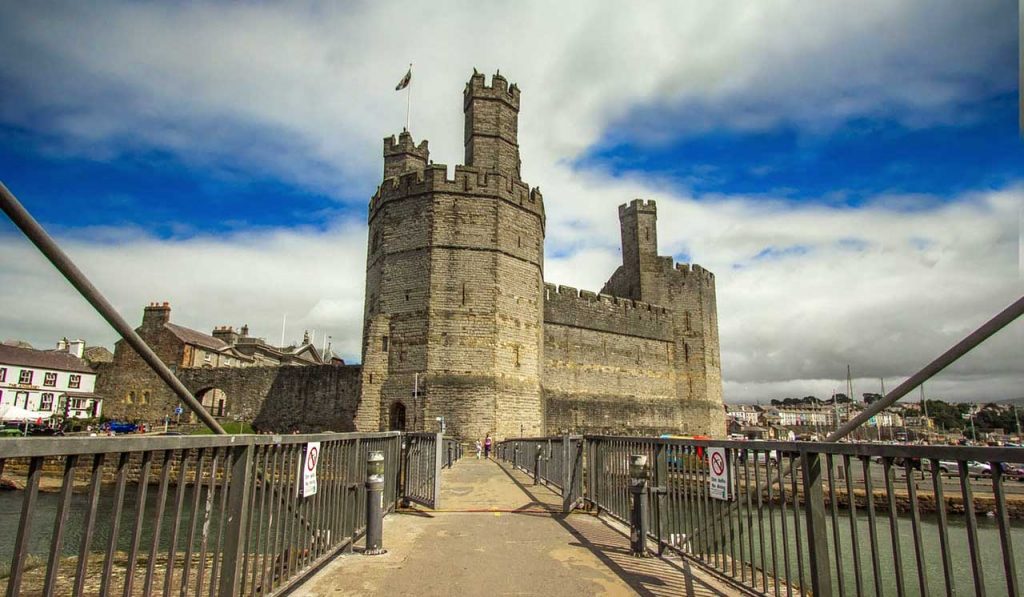Did you know that the beautiful European country of Denmark has hundreds of amazing castles, forts, manor houses, palaces, and historical landmarks? Many of these places are open to travellers from around the world while others are fully restored landmarks used as functioning premises for Royalty and organisations in modern times.
We’ve created a synopsis of the top 10 castles and palaces to visit in Denmark. Keep reading for several more structures worthy of an honourable mention. Go ahead and read about the fascinating historical heritage of the sites, and plan your trip to experience the wonders of Denmark’s culture, people and traditions!
Table of Contents
- 1 10 Most Popular Castles to Visit in Denmark
- 2 17 Less Popular Castles Worth Visiting While In Denmark
- 2.1 11. Nordborg Castle
- 2.2 12. Nyborg Castle
- 2.3 13. Schackenborg Castle
- 2.4 14. Tranekær Slot
- 2.5 15. Valdemars Castle
- 2.6 16. Rosenholm Castle
- 2.7 17. Kronborg Castle
- 2.8 18. Koldinghus Castle
- 2.9 19. Voergaard Castle
- 2.10 20. Vallo Castle
- 2.11 21. Grasten Palace
- 2.12 22. Gammel Estrup Manor
- 2.13 23. Hammershus Castle
- 2.14 24. Vordingborg Castle
- 2.15 25. Borreby Castle
- 2.16 26. Augustenborg Castle
- 2.17 27. Odense Palace
- 3 Conclusion
10 Most Popular Castles to Visit in Denmark
The order of the list is based on Google search volume of each castle = popularity.
1. Amalienborg Castle
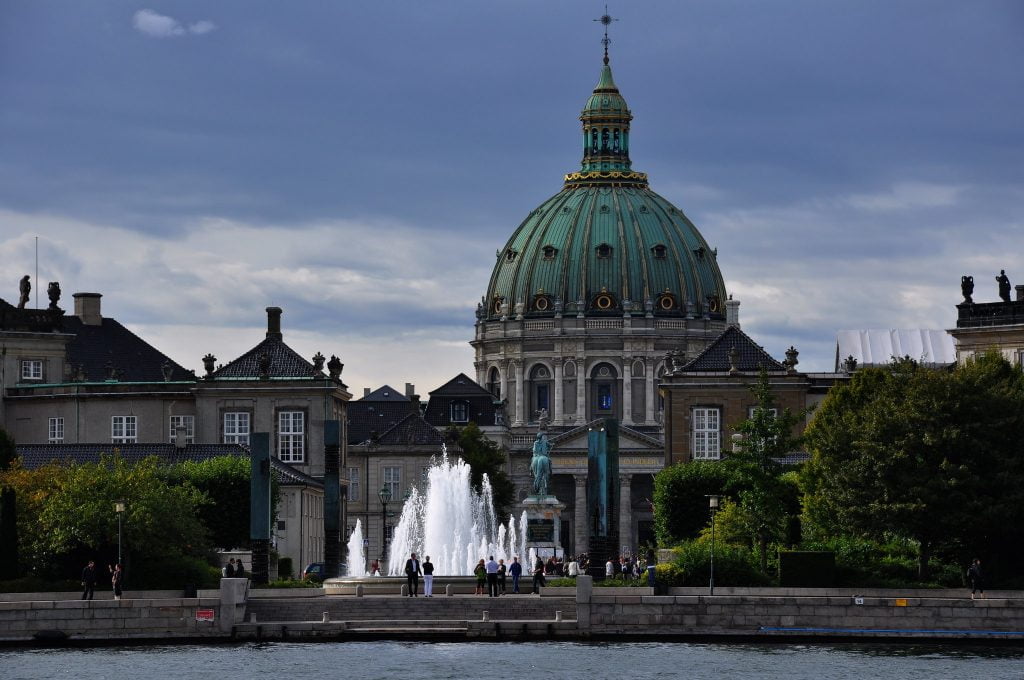
Amalienborg Castle is a visual and architectural masterpiece, the official residence of the Danish royal family since 1794. The grand castle compound is situated in the capital city of Copenhagen, Denmark. The castle estate boasts a great octagonal courtyard enclosed by four identical palace structures in the classical style, with Rococo interior designs.
A spectacular equestrian statue of King Frederick V, commemorating him as the founder of Amalienborg, is centred within the estate’s courtyard. The statue was sculpted by the French artist Jacques-Francois-Joseph Saly and was officially unveiled in 1771, five years after the death of the king.
Today, two of the four palaces are open to the public. The castle grounds are guarded around the clock by the Royal Life Guards. The Amalienborg Museum features historical exhibits of the monarchy throughout the centuries and is a popular destination for tourists.
- Location: Copenhagen, Denmark
- Time built: 1750’s
- Architectural style: Classical, Rococo
- Touring: Allowed. Visit the official website for more information.
2. Christiansborg Palace
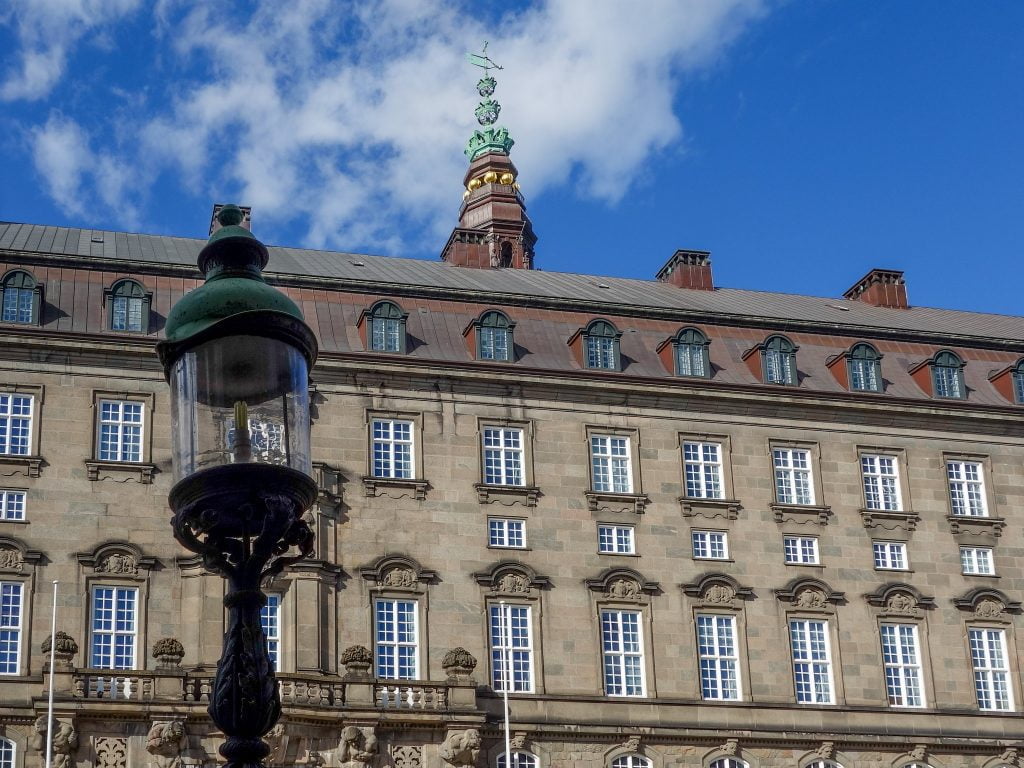
Christiansborg Palace is situated on the islet of Slotsholmen at the center of Copenhagen. Open for the public to explore, it also hosts Denmark’s Supreme Court and the Danish Parliament building. The Palace Chapel, Royal Stables, and Royal Reception Rooms are still used by the monarch.
The first castle at the site was constructed in 1167 with the eventual construction of the third and current structure. The castle site is a delight for architecture enthusiasts, showcasing the Baroque style showgrounds of 1746; the 1826 chapel’s Neoclassical style; and the Neo-Baroque style dominant in the current palace building, completed in 1928.
History fans are fascinated by the wealth of information about the long list of palace owners and the different uses of the Christiansborg site, as well as its significant development throughout the centuries as a key element within the region.
- Location: Slotsholmen islet, Copenhagen, Denmark
- Time built: 1167 to 20th century
- Architectural style: Neoclassical, Neo-Baroque, Baroque
- Touring: Allowed. Visit the official website for more information.
3. Rosenborg Castle
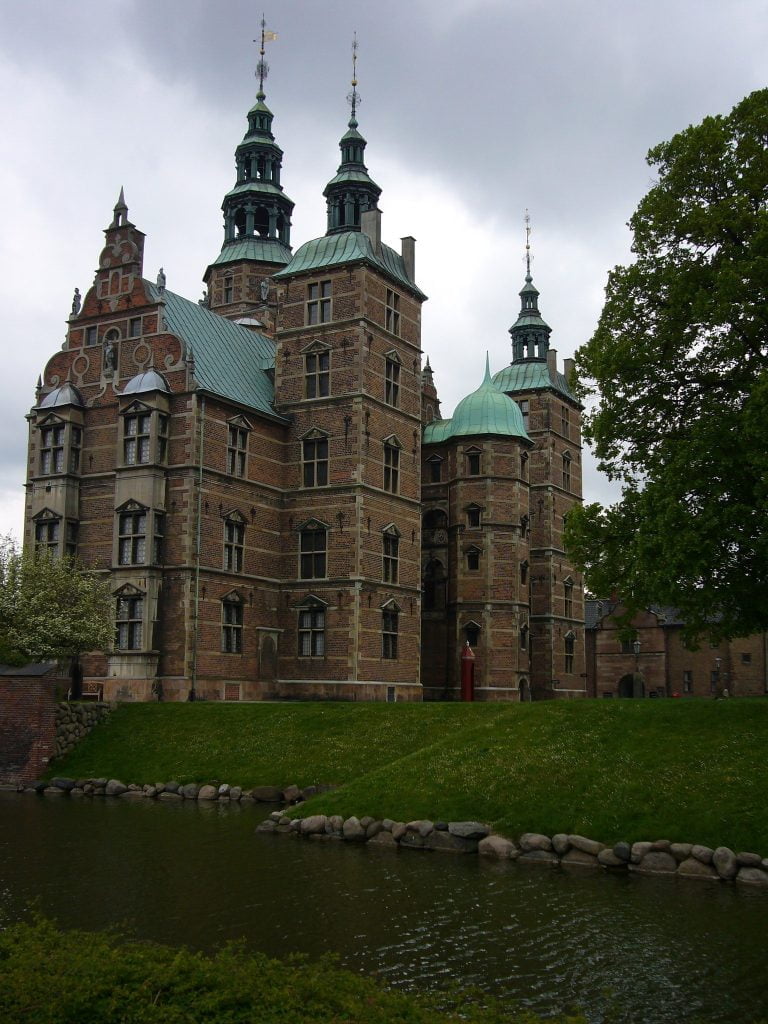
Rosenborg Castle is a magnificent Renaissance structure in Copenhagen. The castle site is one of famous architect Christian IV’s developments, originally constructed in 1606 to serve as a summer country residence. The castle is open to the public with several outstanding reasons to visit.
Within the castle building, The Long Hall was built as an opulent ballroom in 1624 and served as a banquet hall and Royal Reception Hall from approximately 1700. In the latter part of the 19th century, it was renamed the Knight’s Hall.
A castle museum showcases Royal collections, also referred to as the Rosenberg Collections. The castle treasury showcases the Danish Crown Regalia as well as the Crown Jewels. The castle is situated in the “Rosenborg Castle Garden”, also known as “The King’s Garden” (Krongens Have in Danish). Don’t forget to visit the Renaissance embroidered garden while you’re here!
- Location: Copenhagen, Denmark
- Time built: 1606
- Architectural style: Dutch Renaissance
- Touring: Allowed. Visit the official website for more information.
4. Egeskov Castle
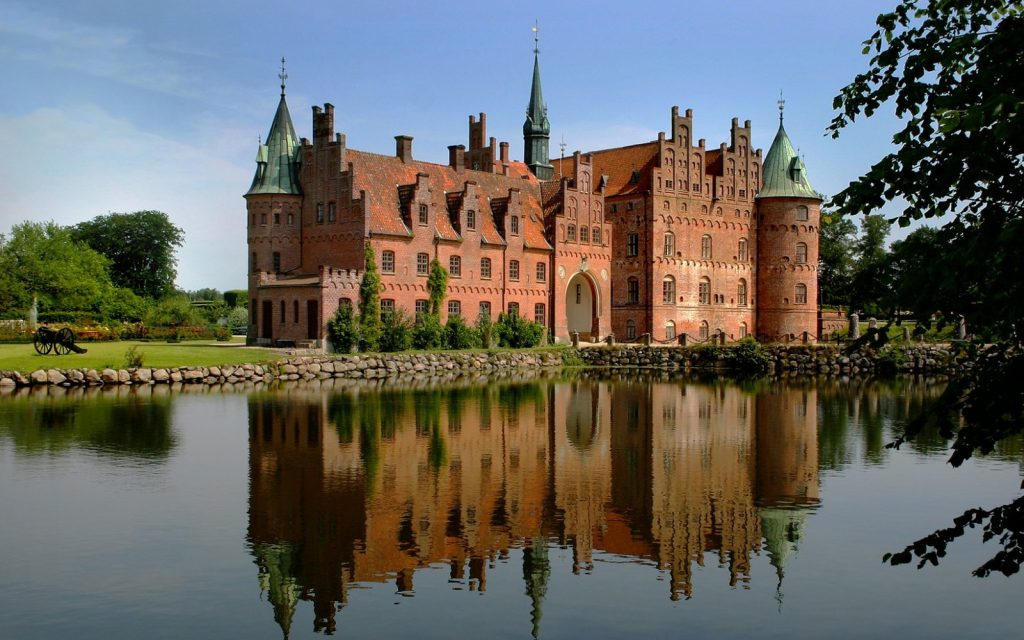
Egeskov Castle–also known as Oak Forest Castle–is a gorgeous Renaissance water castle in the town of Funen, Denmark. The castle was constructed in 1554, by nobleman Frans Brockenhuus to serve as a secure country manor house.
The castle consists of two individual houses joined by a thick wall. Within the structures there are secret stairways and even a hidden well. The castle is surrounded by 49 acres of land sectioned into various lush gardens which are lavishly decorated with ornaments and fountains. Egeskov Castle was opened to the public in 1986 and has become a popular tourist destination. The castle site includes museums and various interesting exhibitions. Amongst the many treasures from around the world in the various rooms there is also the gorgeous Titania’s Palace Dollhouse. This exquisite miniature palace is displayed in the Rigborg Room.
- Location: Funen, Denmark
- Time built: 1554
- Architectural style: Renaissance, late-Gothic
- Touring: Allowed. Visit the official website for more information.
5. Fredensborg Palace
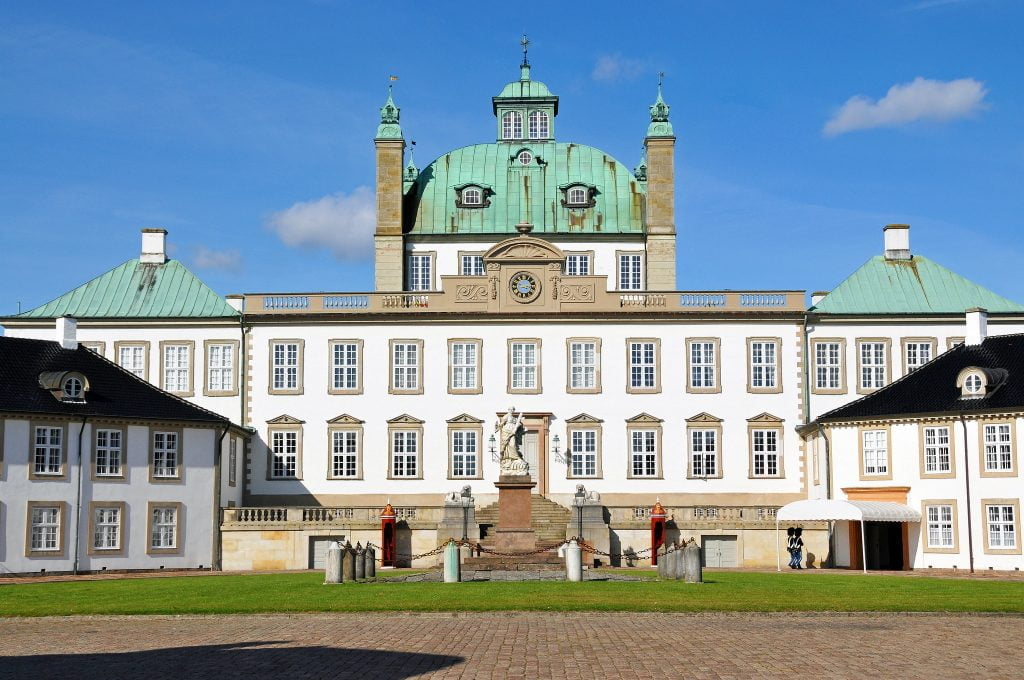
Fredensborg Palace is situated on the banks of Lake Esram on the Danish island of Zealand. It is used as the royal family’s residence in the autumn and spring. The palace is also known as the “Palace of Peace”, since Denmark-Norway and Sweden signed a peace treaty here.
The opulent, French Baroque style palace was built in the early 18th century, commissioned by King Frederick IV. Later additions and modifications seamlessly incorporate Dutch Baroque, Rococo and late-Baroque styles making the site a must-see for all architecture enthusiasts.
The lush, well-maintained Baroque style palace gardens were awarded the European Union Prize for Cultural Heritage in 2021. Fredensborg Palace and private gardens are open to the public from July through the first week of August, only for guided tours. The beautiful public gardens are open to visitors all year round.
- Location: Fredensborg, Denmark
- Time built: Early 18th century
- Architectural style: French-Baroque, Dutch-Baroque, late baroque, Rococo
- Touring: Allowed. Visit the official website for more information.
Revisit More Historic Places Below or Read Further
6. Dragsholm Castle
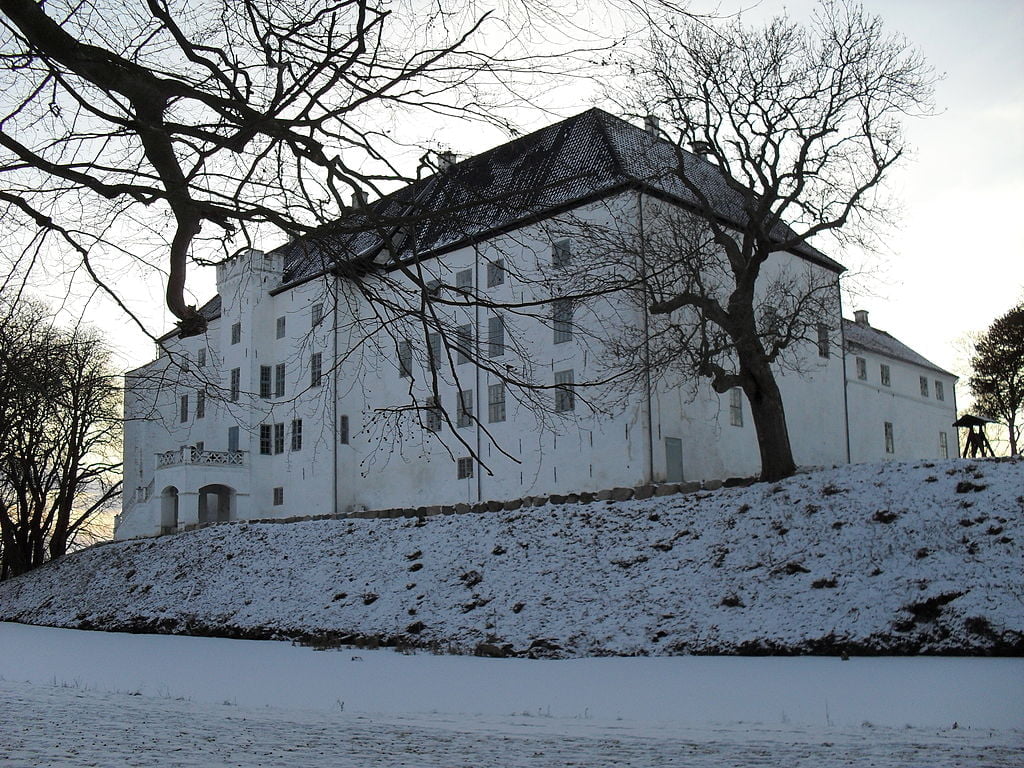
Pristine Dragsholm Castle is situated in Odsherred town on the island of Zealand. The gorgeous Baroque-style castle was originally built as a medieval fortress.
Erected in 1215, the castle was rebuilt in the late 17th century and completed in the early 1700s. The site is believed to be haunted by over a hundred ghosts, including the spirit of the late Bishop of Roskilde and “The Lady in White”, both said to have been imprisoned at the castle site centuries ago.
Today, the ancient castle site is open to the public. With a lush herb garden and beautiful lake, the castle grounds provide tourists with marvelous scenery and a tranquil atmosphere. The site boasts a luxurious hotel with a Michelin-starred restaurant. There are informative, historical guided tours available as well as several activities for visitors to partake in such as hiking, biking, yoga, and golf.
- Location: Odsherred, Denmark
- Time built: 1215, reconstructed 17th century
- Architectural style: Baroque
- Touring: Allowed. Visit the official website for more information.
7. Frederiksborg Castle
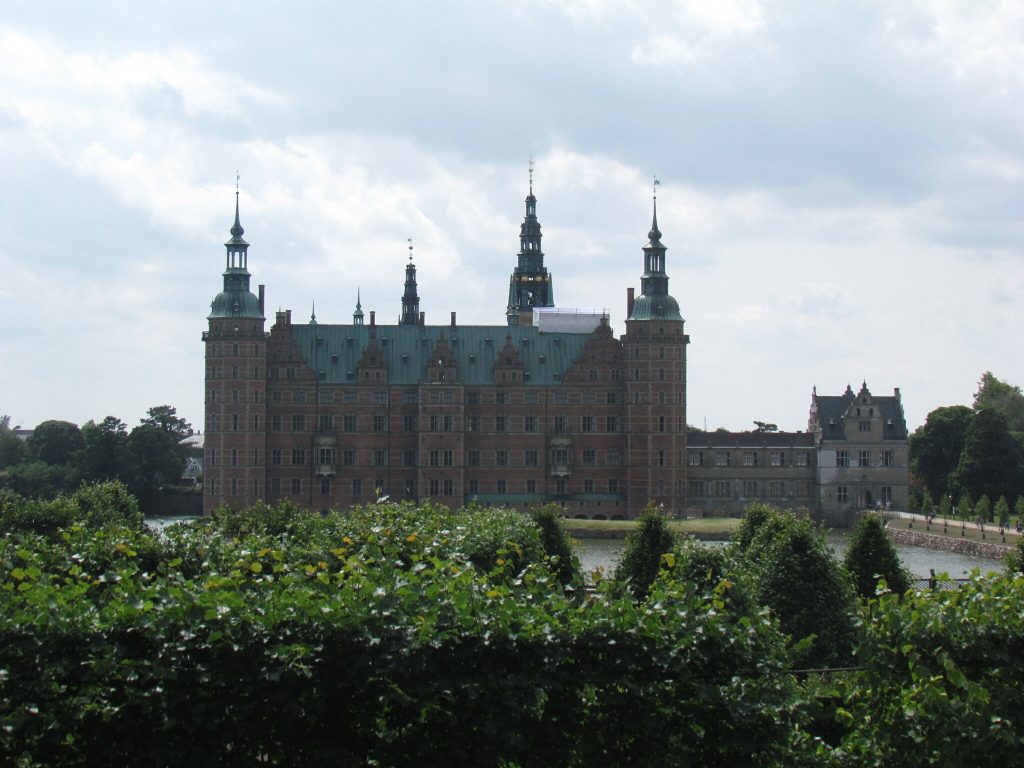
Frederiksborg Castle is a massive palatial complex situated in the town of Hillerod, Denmark–it is renowned for having been the largest Renaissance residence in Scandinavia. The castle grounds extend over three islets in Slotssoen.
Frederiksborg Castle was built in the early 16th century to serve as a royal residence for the king of Denmark-Norway, King Christian IV. The palatial complex was severely damaged by a fire in 1859. Fortunately, public support and contributions resulted in the complete reconstruction of the original site using old paintings and blueprints.
The palatial complex has been open to the public since 1882. Highlights when visiting the Frederiksborg Castle include the sculptural masterpiece by Adrien de Vries known as “Neptune Fountain”, the Frederiksborg Museum (a national history), the Valdemar Room with several history paintings, the chapel building and the magnificent audience chamber.
- Location: Hillerod, Denmark
- Time built: 1620
- Architectural style: Renaissance, Baroque
- Touring: Allowed. Visit the official website for more information
8. Holckenhavn Castle
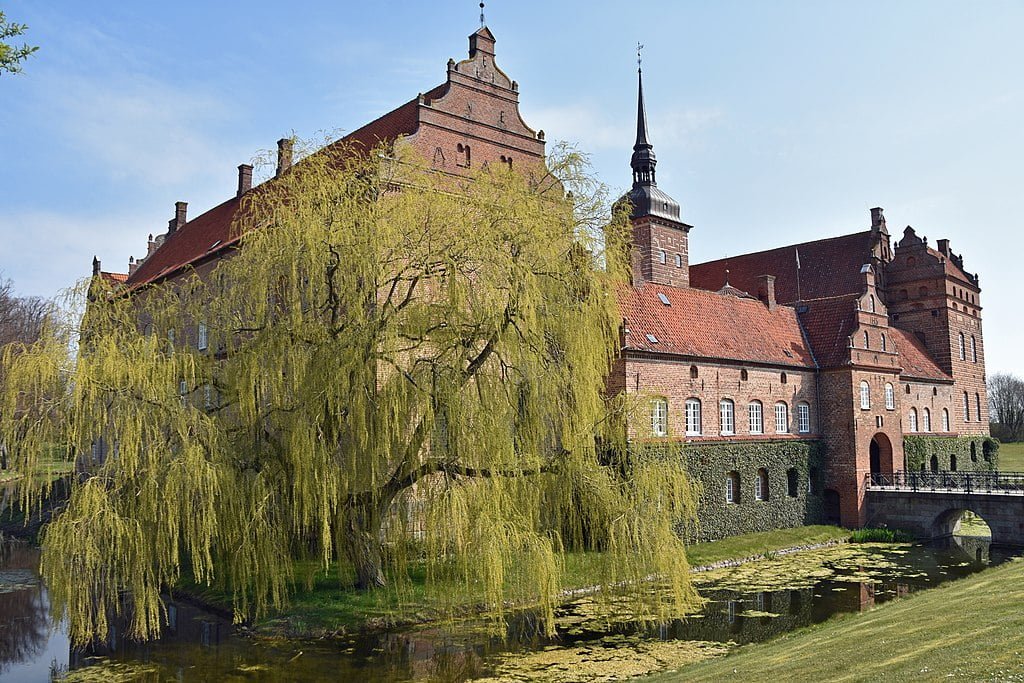
Holckhavn Castle is a picturesque Renaissance castle situated just south of Nyborg in Funen, Denmark.
Built over three generations, the castle compound consists of four winged sections which were completed by the late 16th century. Later, a grand bell tower was added to the site and has been well-preserved to the present day. In 1631, a west wing was added to the site, and in 1634, a gate wing facing the south side was erected. Further additions include a chapel and knights’ hall, both lavishly decorated.
Today, the gorgeous, sectioned 12 hectare (30 acre) park is open to the public. The main castle structure is available to rent for special occasions such as banquets and conferences, as are some of the smaller buildings and dwellings as well.
- Location: Funen, Denmark
- Time built: late 14th century
- Architectural style: Renaissance
- Touring: Allowed. Visit the official website for more information.
9. Marselisborg Palace
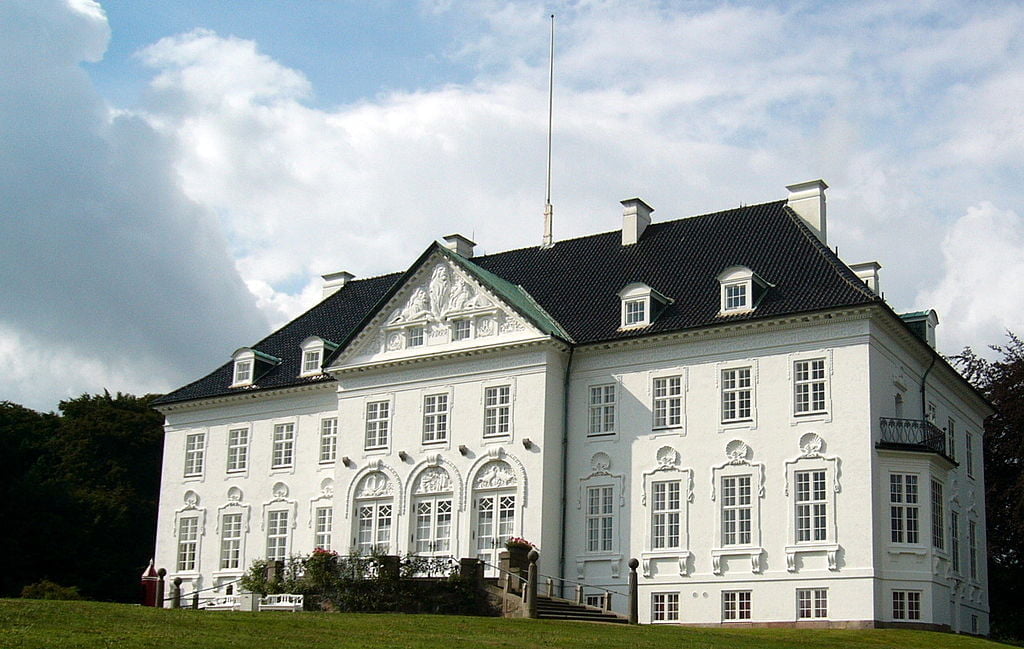
Stately Marselisborg Palace is situated in the country’s second-largest city of Aarhus. The castle is used as a royal residence after the people of Denmark bestowed this privilege upon the Danish royal family. Queen Margerethe II uses the palace during the summer months.
Constructed on the site of the old, 16th-century Marselisborg manor house, the castle was rebuilt according to the architectural plan of Hack Kampmann between 1899-1902. The palace is surrounded by a gorgeous and extensive English Garden named Slotshaven (Danish), meaning “Palace Garden” in English. The fantastic park area is a creation of architect L. Christian Diedrichsen, with grand lawn areas, water wells, and decorative ornaments.
Marselisborg Place is not open to the public. The magnificent park area and the Queen’s picturesque rose garden are open to the public at certain times of the year, when the Danish Royals in occupancy.
- Location: Marselisborg, Denmark
- Time built: 1899-1902
- Architectural style: Neoclassical
- Touring: Allowed. Visit the official website for more information.
10. Sonderborg Castle
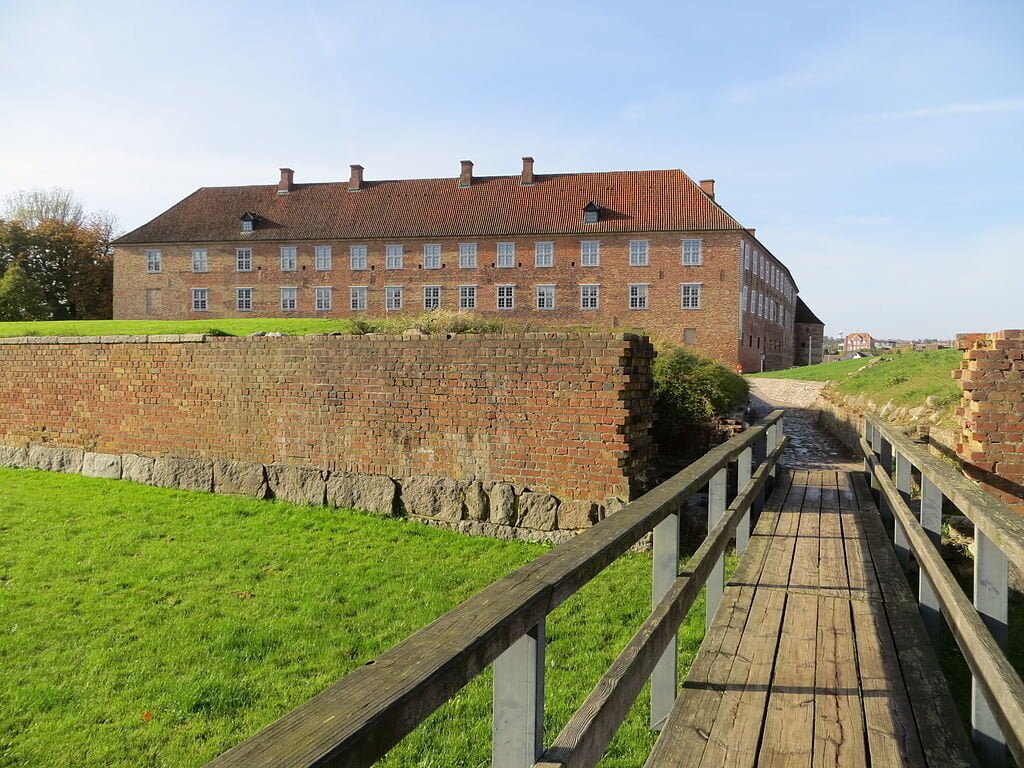
Sonderborg Castle is a magical castle positioned in the center of Sonderborg town, on the island of Als in South Jutand, Denmark. The castle site features breathtaking views overlooking Als Fjord.
Built in 1158 by Valdemar the Great, it is believed the castle’s original purpose was to serve as a fortification to defend against raids by the Wends. It was reconstructed and extended during the centuries of its existence to become a castle complex.
Today the castle site is open to the public and has been home to the Sonderberg Castle Museum since 1921. The museum features several historical and cultural displays showcasing the region’s development from the Middle Ages to the present day. Also to see at the site is the castle chapel and the great hall.
- Location: Sonderborg, Denmark
- Time built: 1158
- Architectural style: Medieval, Renaissance interior
- Touring: Allowed. Visit the official website for more information.
Planning to Visit Nearby Countries? Check Out These Best Castles Lists:
17 Less Popular Castles Worth Visiting While In Denmark
If you are a castle enthusiast, you must take out the time to visit these equally spectacular castles in Denmark as well:
11. Nordborg Castle
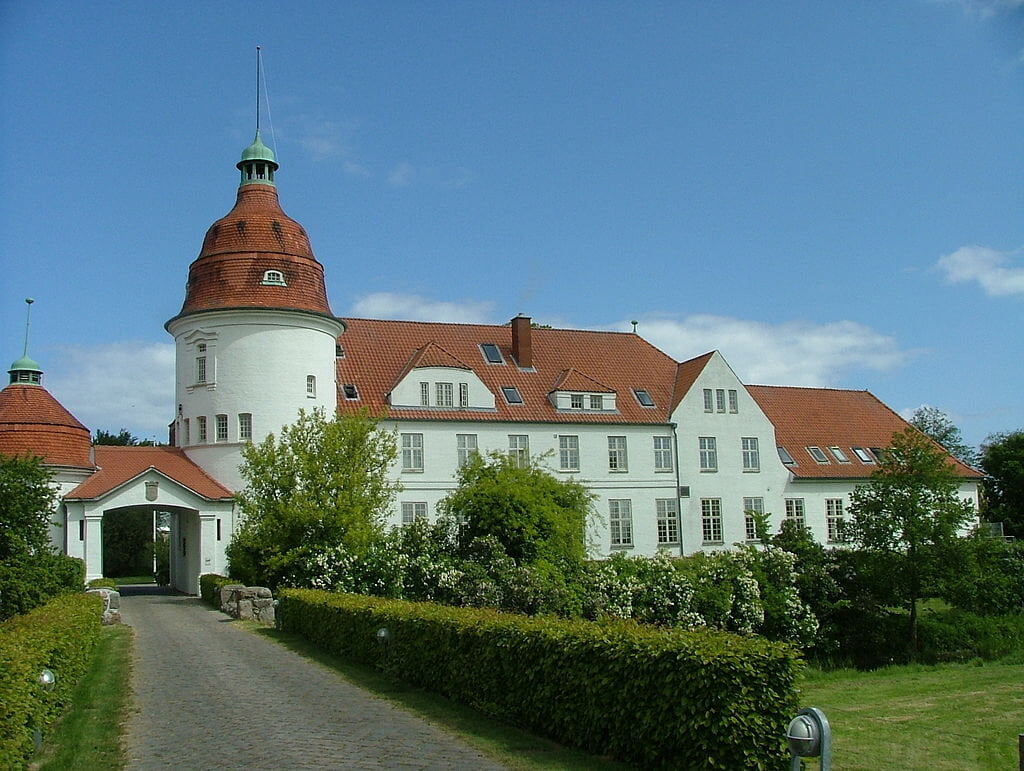
Not the largest of castles, yet gorgeous, Nordborg Castle is situated in the municipality of Sonderborg, on Als Island. The castle is most popular in modern times as the background of the Danish Als music festival.
With a long list of owners and a rich history, the castle is fascinating to study. The main structure was built, destroyed and rebuilt multiple times.
Today, the castle serves as a boarding school. The site has been used for this purpose since 1922, after it had been fully revamped by Johan Hansen’s foundation, Stiftelsen Nordborg Slot.
- Location: Sonderborg, Denmark
- Time built: Reconstructed early 20th century
- Architectural style: Castle/boarding school
- Touring: Allowed. Visit the official website for more information.
12. Nyborg Castle
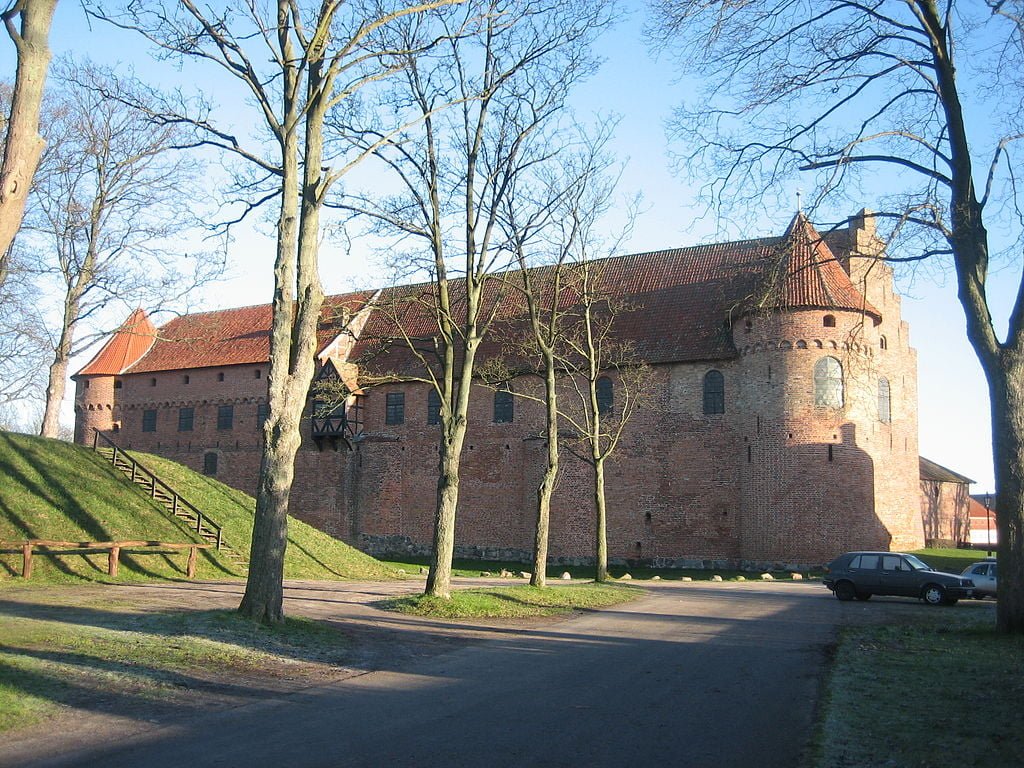
Nyborg Castle is a beautifully reconstructed castle complex situated on Funen Island in Denmark. The castle forms an integral part of Danish history as the location for the signing of Denmark’s first constitution in 1282. The castle also housed the country’s first parliament, Danehof, until 1413.
The castle stood for centuries until being demolished in the early 18th century, with the stones repurposed for Odense Palace. The National Museum of Denmark raised funds and reconstructed Nyborg between 1917 and 1923. The castle site, including the Kerteminde Museum housed inside, is open to the public today.
- Location: Funen, Denmark
- Time built: 12th century
- Architectural style: Medieval
- Touring: Allowed. Visit the official website for more information.
13. Schackenborg Castle
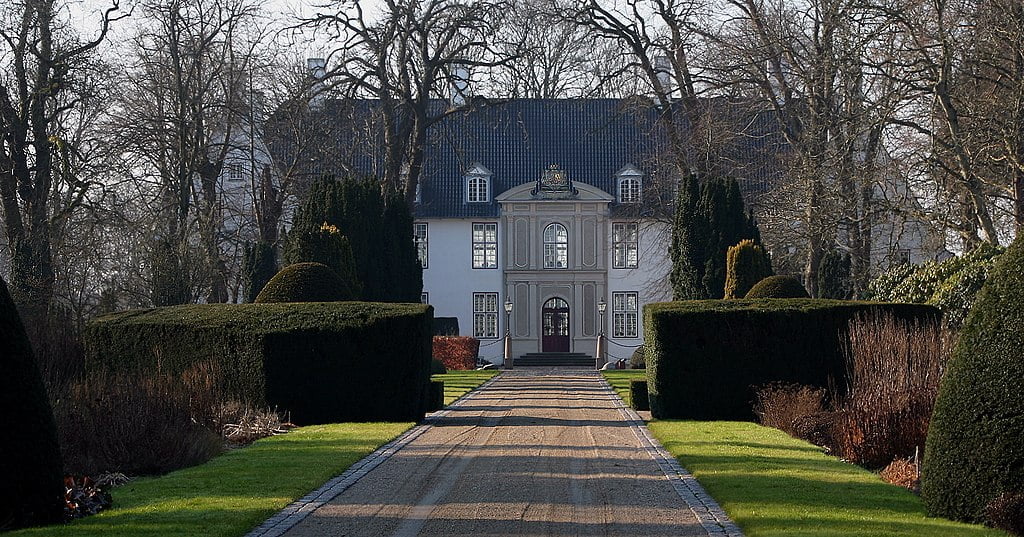
Beautifully-designed Schackenborg Castle is situated in the southern Jutland region in Mogeltonder. The castle was built by the bishops of Ribe, as a fortification to defend against the Germanic Frisians.
In 1661, the nobleman Hans von Schack destroyed most of the original manor house and erected the opulent Baroque-style Schackenborg Castle in its place. Since 2014 the castle has been owned by a foundation.
The castle is not open to the public at present. The lush gardens surrounding the castle are only open to the public for guided tours during certain times in the summer.
- Location: Mogeltonder, Denmark
- Time built: Reconstructed 1661
- Architectural style: Baroque
- Touring: Not allowed.
14. Tranekær Slot
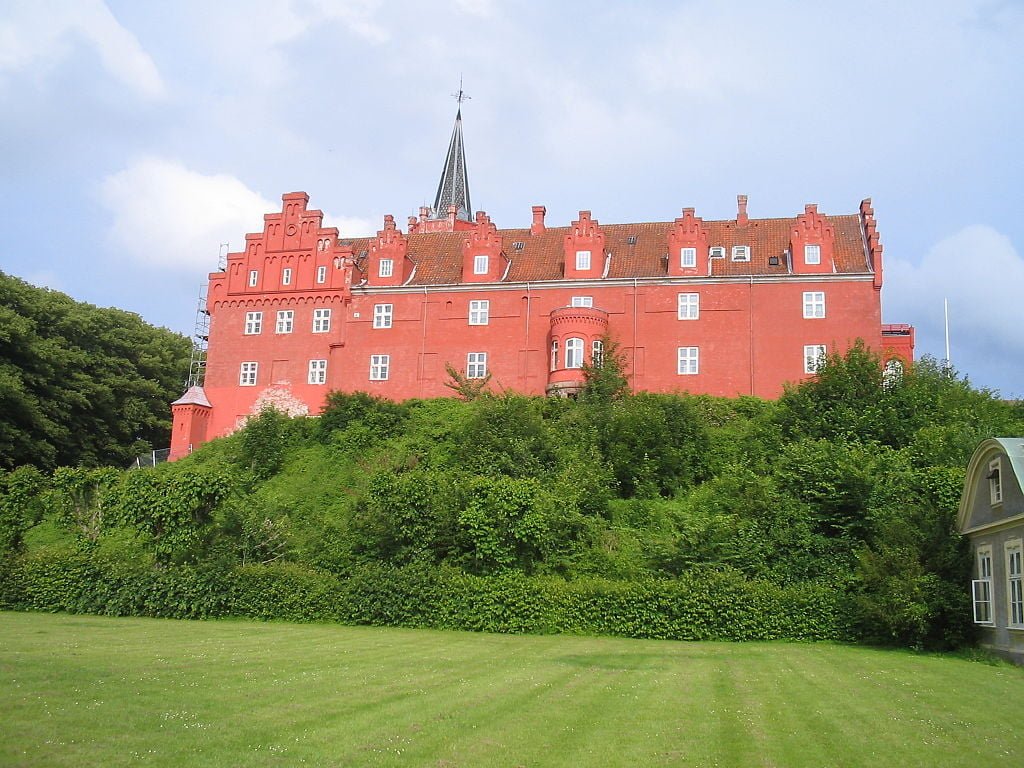
Tranekaer Castle is a fairy-tale site situated on the picturesque island of Langeland. The ancient castle has been traced back to the 13th century when it was described as a moated fortification built on a steep, elevated portion of land.
The castle estate is owned & resided in by Count and Countess Ahlefeldt-Laurvig in the present day. There are guided tours of the castle and grounds available on specified dates of the year. Wonderful meals are prepared for castle visitors by a chef and the castle may be booked for conferences. Hunting trips are also available for tourists.
- Location: Langeland, Denmark
- Time built: 13th century
- Architectural style: Medieval
- Touring: Allowed. Visit the official website for more information.
15. Valdemars Castle

This lovely manor estate is situated on Tasinge Island in the southern region of the country. Valdemars Castle was erected in 1639, as ordered by King Christian IV, and completed in 1644. The castle boasts an interesting history as the property of the luel-Brockdorff family for eleven centuries.
The site is open to the public during certain months of the year and on public holidays. Baron luel-Brockdorff and his family reside in the castle. The site is extensive and includes the main manor house, a chapel, two museums, and an exhibition of the family’s hunting trophies.
- Location: Tasinge, Denmark
- Time built: 17th century
- Architectural style: Manor house
- Touring:Allowed. Visit the official website for more information.
Revisit More Historic Places Below or Read Further
16. Rosenholm Castle
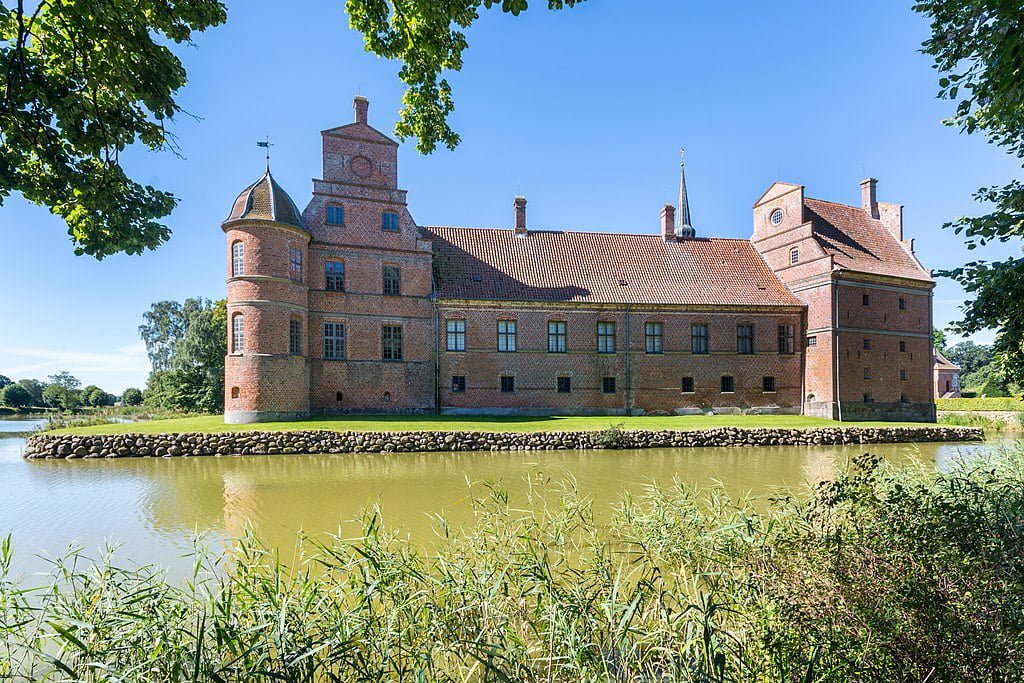
Rosenholm Castle is an Italian Renaissance manor house on Djursland in Denmark. It is believed to be the oldest family-owned castle in Denmark.
Heard of during the 14th century when it was owned by the Catholic Church, it was seized by the Crown during the Reformation in 1536. The castle was given to the Rosenkrantz family by Danish King Frederick II. The interior of the manor house was renovated in the 1740s in the Baroque style.
The castle is only open for guided tours booked in advance, at certain times of the year.
- Location: Djursland, Denmark
- Time built: 14th century
- Architectural style: Italian Renaissance, Baroque
- Touring: Allowed. Visit the official website for more information.
17. Kronborg Castle
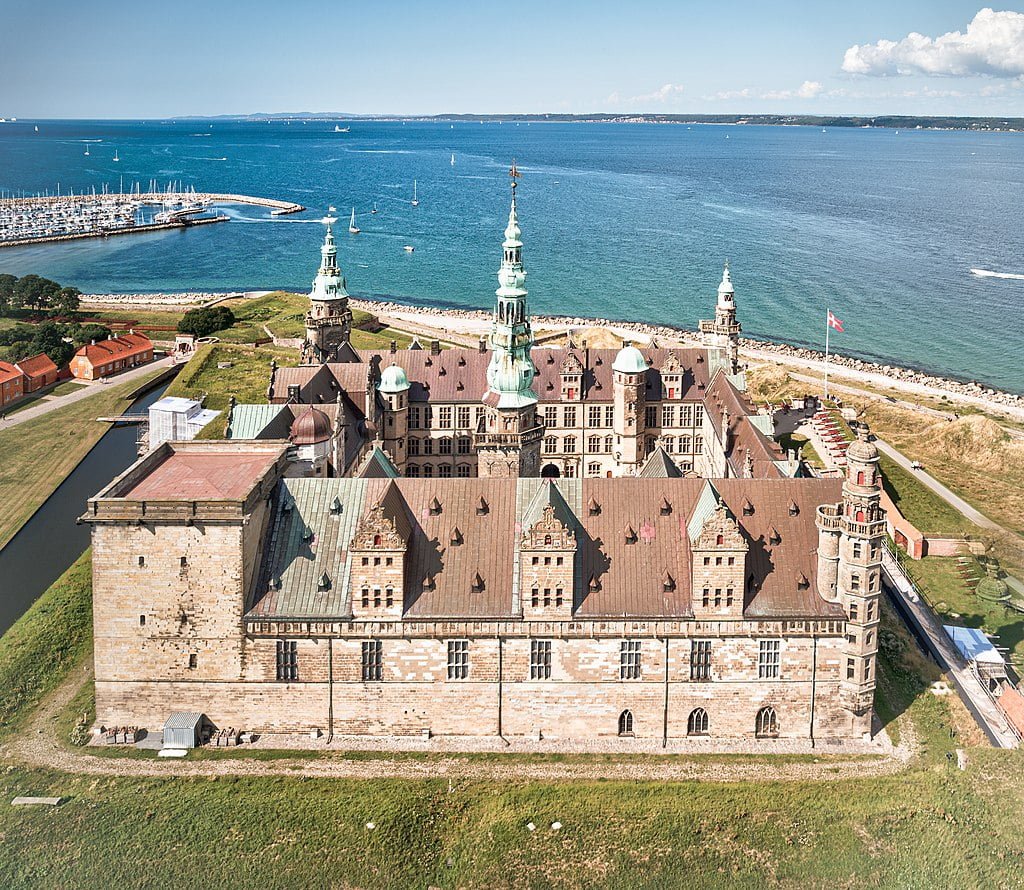
Kronborg Castle is a castle and fortification situated in the town of Helsingor, Denmark. The castle was declared a UNESCO World Heritage Site in 2000.
Originally built in the 1420s as a Middle Ages military fortification by King Erik VII, the site was completely revamped into a gorgeous Renaissance castle from 1574-1585 by King Frederick II. Severely damaged by a fire in 1629, the castle was rebuilt to its former glory by King Christian IV. Around 1923, the castle was opened to the public after being fully renovated.
- Location: Helsingor, Denmark
- Time built: Early 15th century
- Architectural style: Medieval, Renaissance
- Touring: Allowed. Visit the official website for more information.
18. Koldinghus Castle
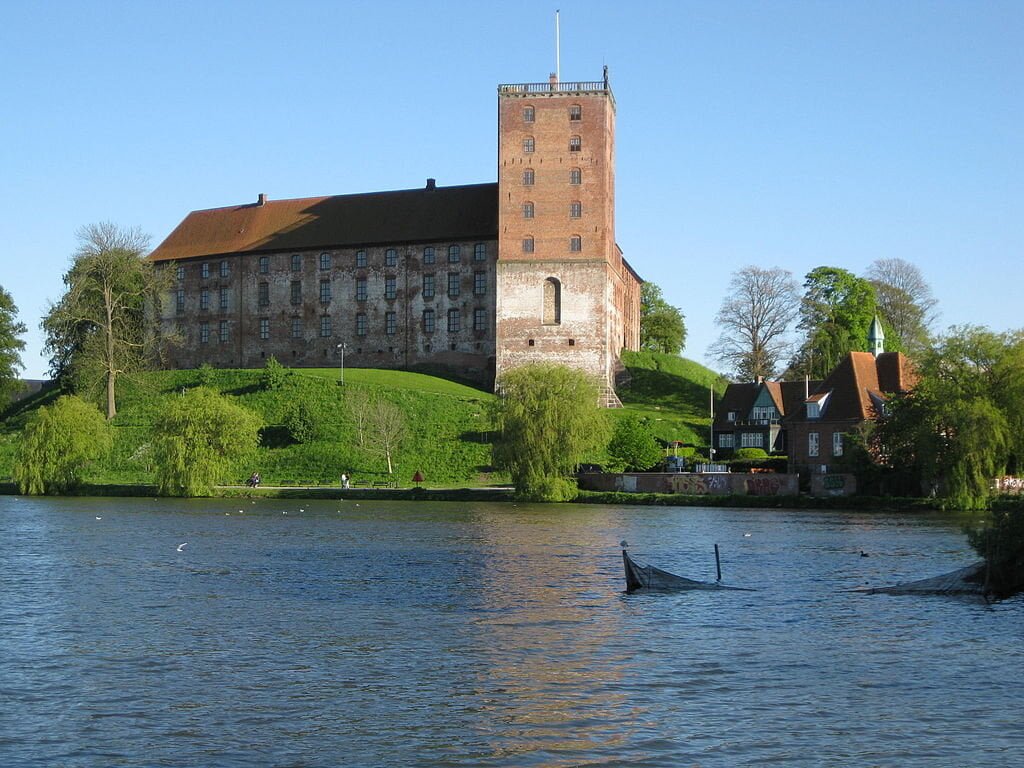
The Royal Koldinghus Castle is situated on a hill in the center of Kolding, Denmark. Built in the 13th century as a defensive fortress, it was remodeled in the 16th century by King Christian III to be used as the royal manor house.
The castle was in ruins for several decades after the Napoleonic Wars; it was nonetheless frequented as a historical landmark. A complete restoration of the old castle was completed in 1991. Nowadays, the castle houses a fantastic historical and cultural museum which is open to the public.
- Location: Kolding, Denmark
- Time built: 13th century, 20th century reconstruction
- Architectural style: Medieval, classic Rococo
- Touring: Allowed. Visit the official website for more information.
19. Voergaard Castle
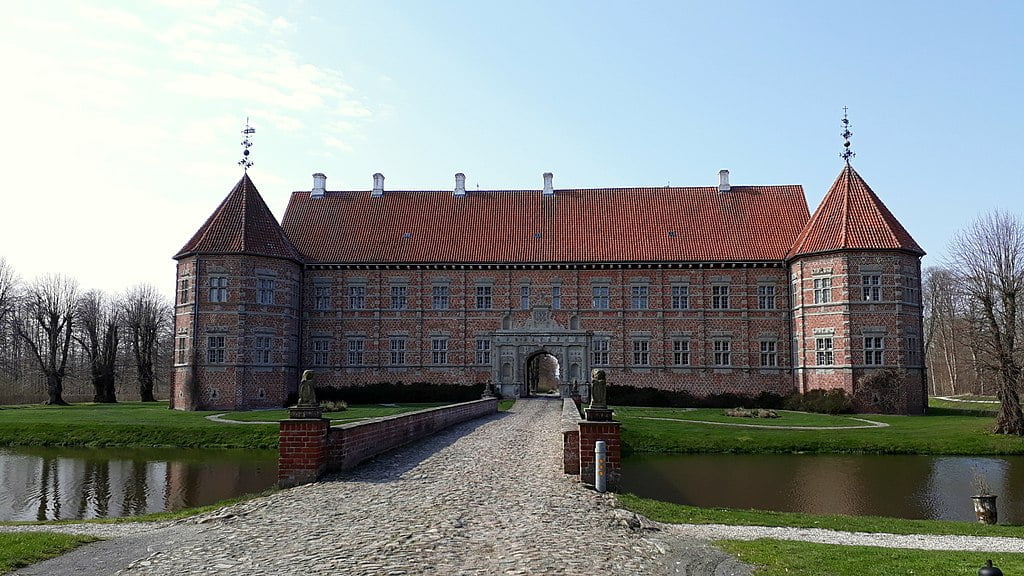
Voergaard Castle is a splendid Renaissance-style manor house first mentioned around 1481. The site is situated six miles north of Dronninglund City, on the North Jutland Peninsula, Denmark. The L-shaped castle is moated, its east wing is bordered by two octagonal towers with a gated entrance.
Voergaard Castle was extensively renovated over a period of several years during the mid-20th century, by Oberbech Claasen. After his death in 1963, the castle was passed onto a foundation. Today the castle and Claasen’s art collection are open to the public.
- Location: North Of Dronninglund, Denmark
- Time built: 1481
- Architectural style: Renaissance
- Touring: Allowed. Visit the official website for more information.
20. Vallo Castle
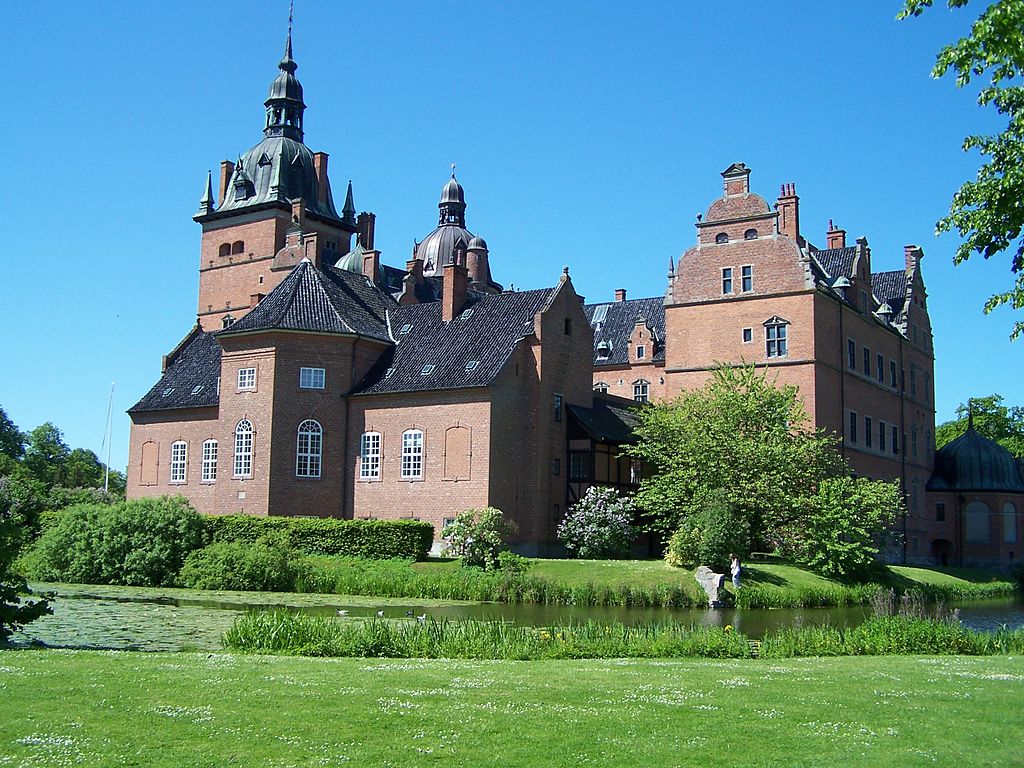
Vallø Castle is a gorgeous manor house situated on the island of Zealand. The castle is believed to have existed from the 14th century. Between 1554-1661, it was divided into two separate sites named West Vallø and East Vallø.
Today, the castle site is owned by the Vallo Foundation. The site serves as a residential complex for unmarried, widowed, and divorced female nobility. The site is not open to the public, but tourists are able to look view the site from the surrounding area.
- Location: Stevns Municipality, Denmark
- Time built: 14th century
- Architectural style: Manor house
- Touring: Allowed. Visit the official website for more information.
21. Grasten Palace
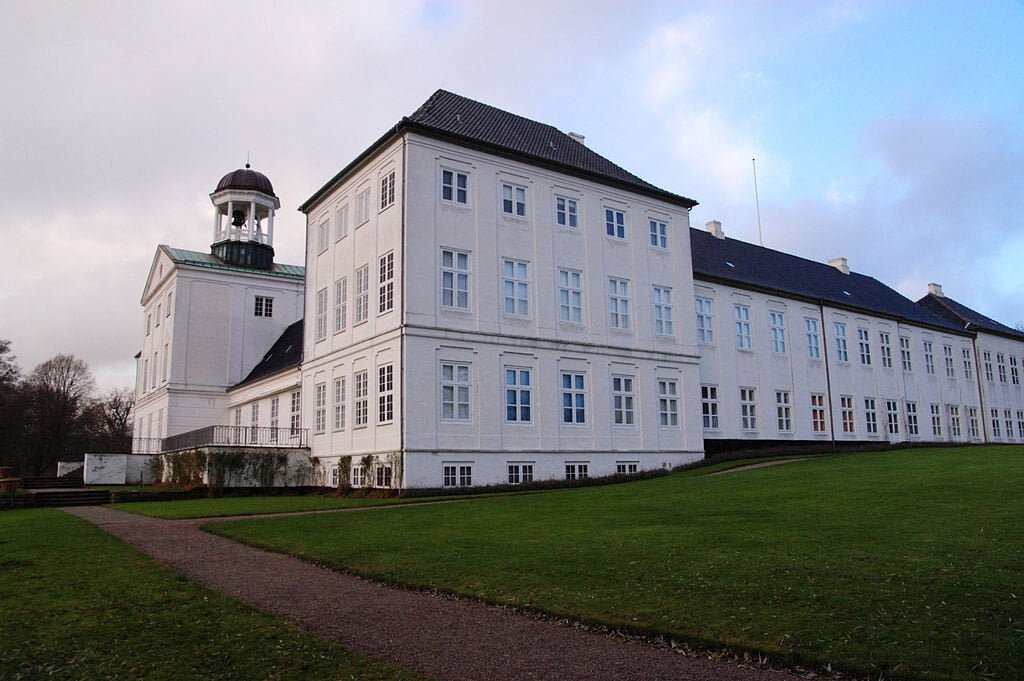
Grasten Palace is a picturesque palace situated in Grasten, in the Jutland region of southern Denmark. Built in the 16th century as a hunting lodge, the castle burnt to the ground and was reconstructed as a castle in 1603.
This second building is the present-day royal summer residence. The palace building exterior remains up-kept in the traditional whitewash. The grounds include extensive stables and gardens. The Palace Chapel is open to the public to visit and the chapel services (given in German and Dutch) are open for the public to attend.
- Location: Grasten, Denmark
- Time built: 16th century
- Architectural style: Baroque, Modern
- Touring: Allowed. Visit the official website for more information.
22. Gammel Estrup Manor
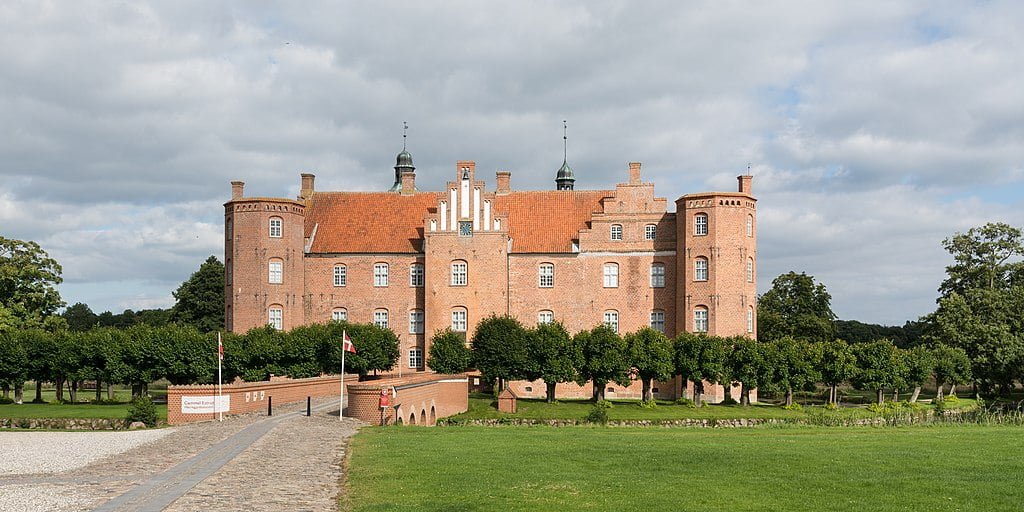
Gammel Estrup Manor features a blend of Renaissance and Gothic architectural styles. The manor is situated around twelve miles east of Randers in Jutland, Denmark. Originally built as a moated stronghold, renovated by nobleman Eske Brock. The Brock family owned the manor estate until 1625, before selling to the Skeel family.
Gammel Estrup Manor has housed a history museum since 1930. The museum is open to the public. There is also a horticulture research center and a large apple orchard in close proximity to the manor house building.
- Location: Randers in Jutland, Denmark
- Time built: late 15th century
- Architectural style: Renaissance and Gothic
- Touring: Allowed. Visit the official website for more information.
23. Hammershus Castle
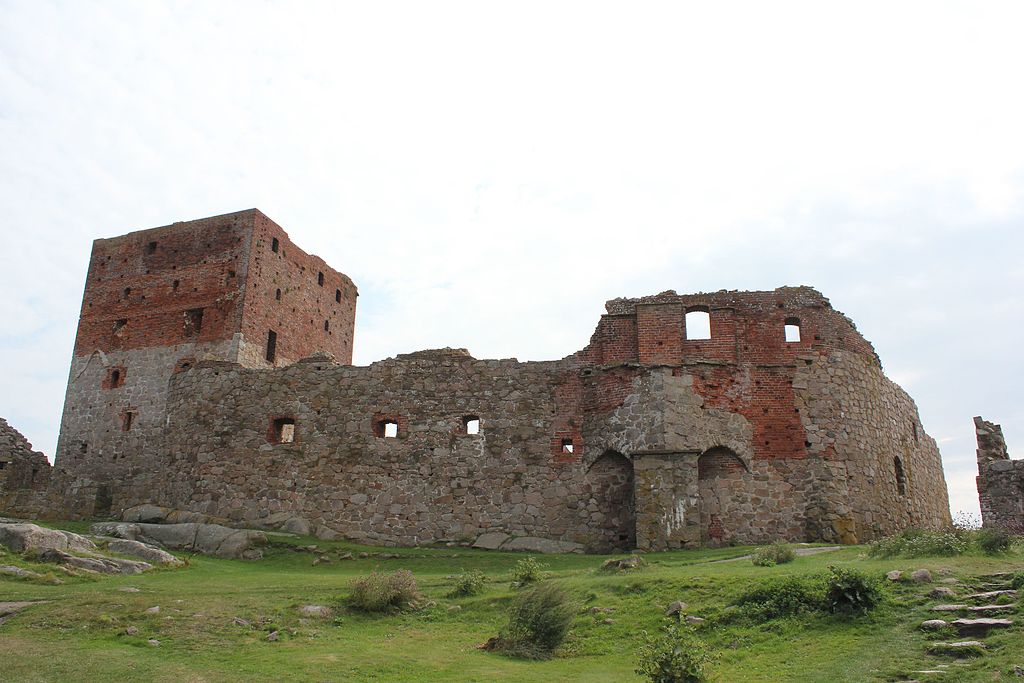
The Hammershus Castle ruins are situated at Hammeren, at the northern point of Bornholm, Denmark. Built in the 14th century as a fortification, it is believed that the castle’s original purpose was as a private dwelling for the archbishop of Lund. The castle used to be the largest fortress in Scandinavia before its destruction.
The castle site ruins were only partially restored in the 1900s after being destroyed around 1750. Today, the castle ruins site is open to the public for exploration. The site offers visitors glorious views of the Bornholm ocean and shoreline.
- Location: Bornholm, Denmark
- Time built: 14th century
- Architectural style: Medieval fortress
- Touring: Allowed. Visit the official website for more information.
24. Vordingborg Castle
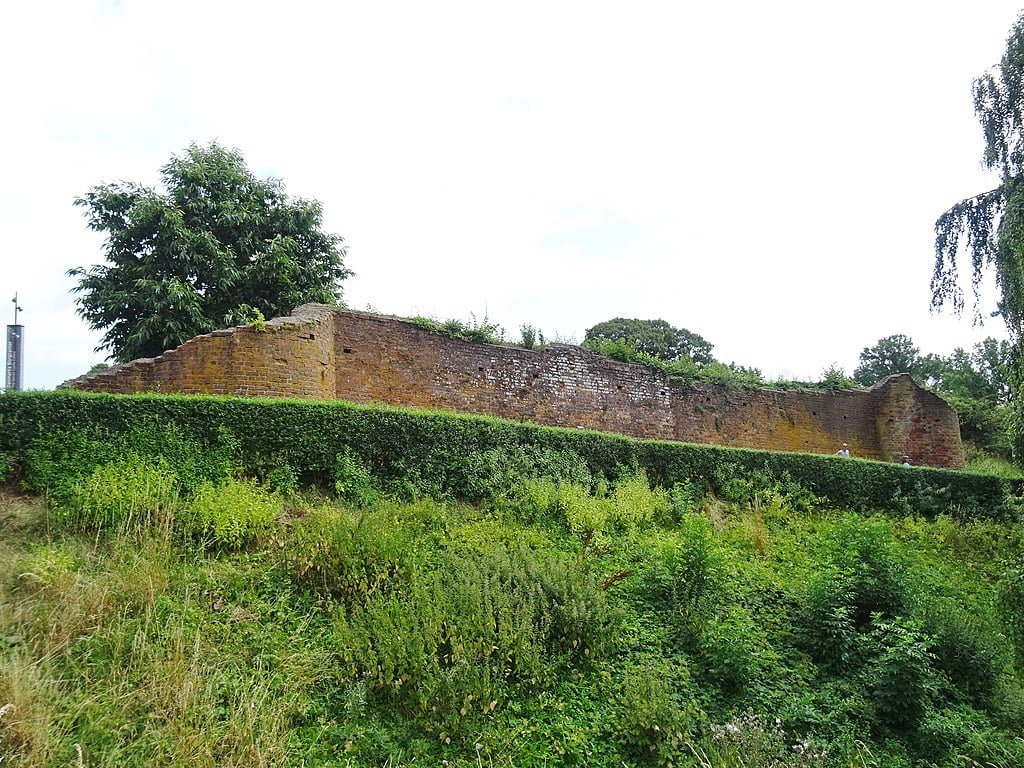
The Vordingbord Castle ruins site is situated upon a hill overlooking the town of Vordingbord, Denmark. Danish King Valdemar I commissioned the building of the fortification around 1175. By the time of King Valdemar IV, the castle site included a fortified wall, half a mile in length, as well as nine grand towers. The fortress was later partially broken down to build a palace that was never occupied and eventually demolished as well.
The ruins are open to the public. Visitors are also able to tour the museum and botanical gardens located next to the site.
- Location: Vordingbord, Denmark
- Time built: 1175
- Architectural style: Medieval
- Touring: Allowed. Visit the official website for more information.
25. Borreby Castle
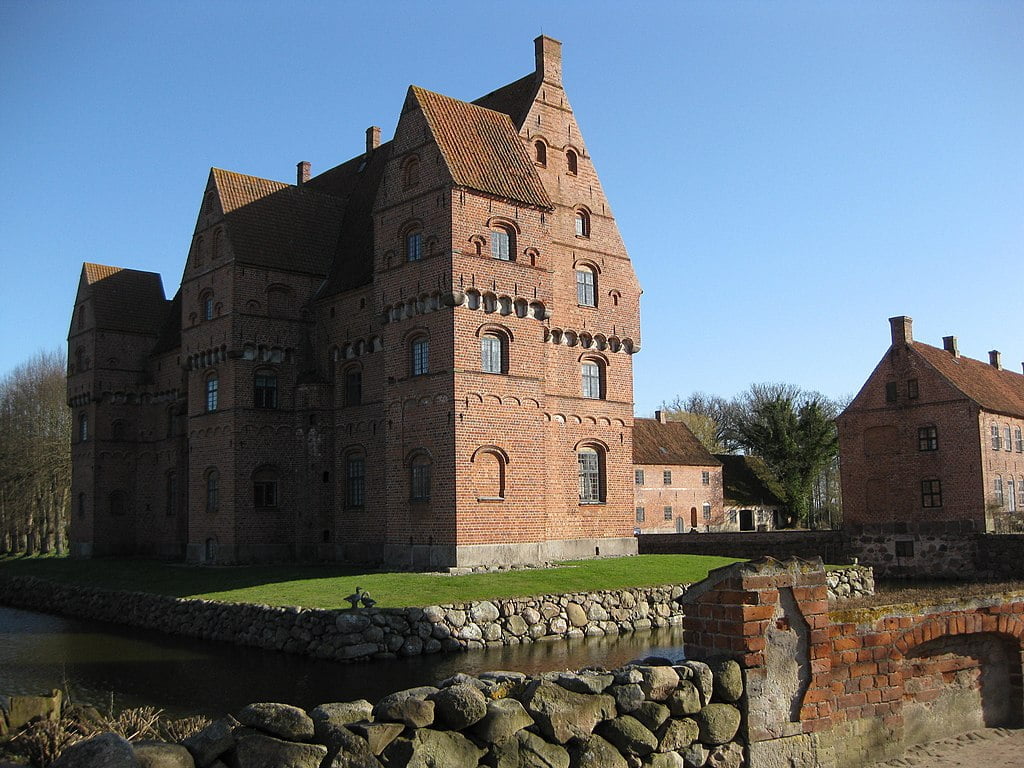
Borreby Castle is a captivating manor house situated in the south-eastern part of Zealand Island in Denmark. Already heard of in 1345, the manor house passed through the Urne noble family and was owned by the Bishops of Roskilde from 1410 until it was seized by the Crown in 1536 after the Reformation.
In the present day, the castle is open to the public for scheduled guided tours and visitors are permitted free access to the outer courtyard and the park areas. The site also includes Borreby Art Gallery and Borreby Theatre, both popular tourist attractions.
- Location: Borreby, Denmark
- Time built: 1345
- Architectural style: Medieval, Renaissance
- Touring: Allowed. Visit the official website for more information.
26. Augustenborg Castle
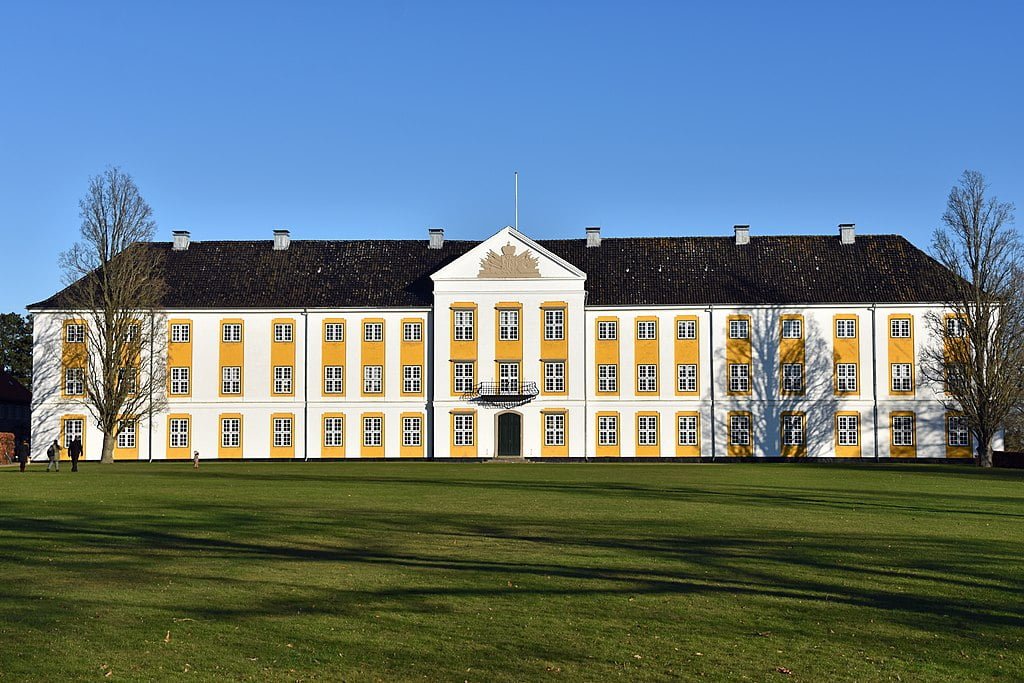
Augustenborg Palace is an extensive palatial compound situated on Als Island in the town of Augustenborg, Denmark. The building work for a manor house at the site commenced between 1660-1664, with a further expansion in 1733. The main palace we see today was built between 1770-1776.
In 1921, the site became the property of the Danish state and housed a psychiatric hospital from 1932. Today, the site is open to the public. There is an exhibition showcasing the history of the site and town. The grounds of the site include a 19th-century landscaped park.
- Location: Augustenborg, Denmark
- Time built: 1660-1664
- Architectural style: Baroque, Rococo
- Touring: Allowed. Visit the official website for more information.
27. Odense Palace
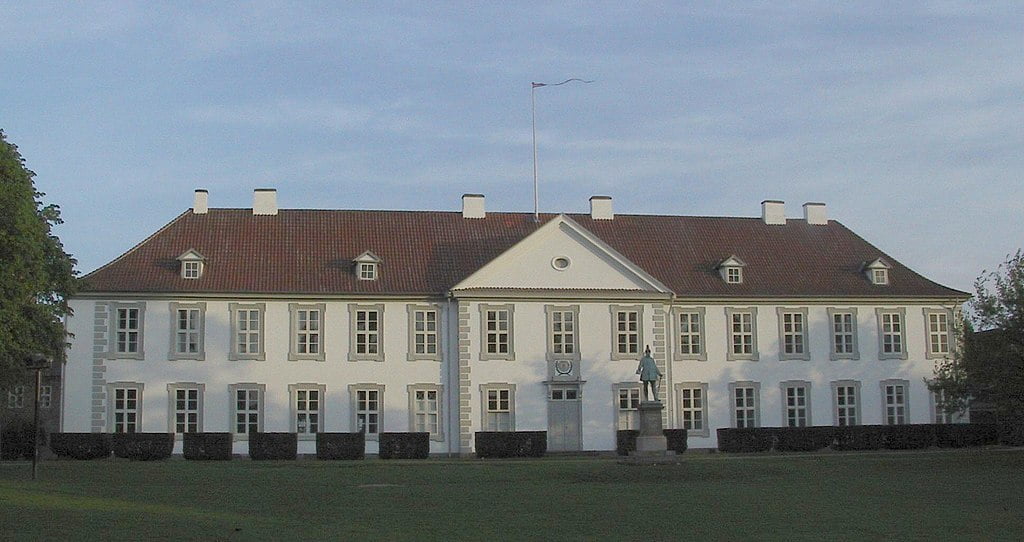
Odense Palace stands proudly in the town of Odense on Zealand Island, Denmark. The site was first developed in the 15th century, with later Baroque-style construction in 1723, including the white main building with thirteen bays. At this time the gardens were also added to the palace grounds, including the well-known royal garden known as the “King’s Garden”.
Presently, the palace is a private residence and a Danish administrative center, visitors are not permitted inside. However, visitors are permitted to explore the extensive parks and French-style gardens all year round.
- Location: Odense, Denmark
- Time built: 15th century
- Architectural style: Baroque, French classic
- Touring: Allowed. Visit the official website for more information.
Planning to Explore Europe? Check Out These Best Castles Lists:
Conclusion
Fascinating and alluring, Denmark is one of the most beautiful countries in the world! With so many gorgeous and historically significant landmarks, the country draws millions of tourists each year. Plan a refreshing and eye-opening trip to this fantastic European destination, and experience Danish culture firsthand.

